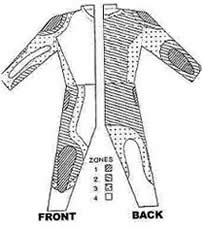Protection from injury
A German study of motorcycle crash casualties, found that riders wearing protective clothing spent less time in hospital, and returned to work on average 20 days earlier, than those who were not protected. The protected riders were also 40% less likely to have suffered a permanent physical defect. The authors concluded that protective clothing was significantly effective in preventing or reducing at least 43% of injuries to the skin and soft tissue and 63% of deep and extensive injuries (Schuller, 1986).
What parts of the body do you need to protect?
Information about injury risk patterns has not been widely available to motorcyclists but it does exist. Research from Germany, UK and USA all confirm similar patterns of injuries sustained by motorcyclist (Hurt et al, 1981, Craig et al, 1983, Schuller et al, 1986, Otte et al, 2002).
We have combined information from a number of sources to construct a diagram of injury zones and recommended protection levels. The injury data is based on research by Otte & Middlehavre, (1987) and was confirmed as typical of the pattern of injury in a report on motorcycle safety by the European Experimental Vehicles Committee (EEVC,1993).
Click here to see the injury risk zones
What research has found
Otte (2002) found that riders wearing protective clothing had significantly fewer leg injuries in crashes at the same relative speed (eg 40% vs 29% injury free at under 50 kph). He also identified a significant benefit in reducing foot injuries for riders wearing motorcycle boots.
There are other studies that also confirm the benefits of protective clothing (e.g.Hurt et al, 1981; Zettas et al, 1979; Otte & Middlehavre, 1987; Hell & Lob, 1993).
Down load a full copy of our report on protective clothing and injury reduction from link below. Go to Reference List if you would like to find out more about these studies.
The impact in most crashes actually occurs at relatively low speeds (75% at less than 48 kph, RoSPA, 2001, p18). These are the crashes where protective clothing is of most value, when you are sliding and tumbling along the road surface but not if you hit a solid object. There is a limit to what protective clothing can do. When it comes to serious injuries to the limbs and torso, there is little difference between riders with and without protective clothing (Otte, 2002).
- Nothing can protect you from the impact of hitting a solid object at high speed.
- Nothing can protect you from being bent or crushed between the road and another vehicle, nor from internal injuries caused by the shock waves of high energy impacts.
However, the right protective clothing can almost certainly:
- Prevent most of the cuts, gravel rash and friction burns as you slide along a road.
- Protect you from exhaust pipes burns if the bike ends up on top of you.
- Reduce the risk of infection and complications caused by road dirt in open wounds.
- Save you from having the muscles and skin of your hands and legs stripped from your body. The medical term is “de-gloving” – think about it.
- Prevent or reduce the severity of some fractures and joint damage.
What is the "right" protective clothing? How should riders spend their "safety dollars" ?
In addition to protection from injury, also refer to the sections on Protection from weather and Protection from SMIDSY, for more information on how to choose protective clothing.
The majority of motorcyclists wear a helmet and jacket, they are less likely to wear motorcycle boots, gloves or pants. See our survey What Australian riders wear.


